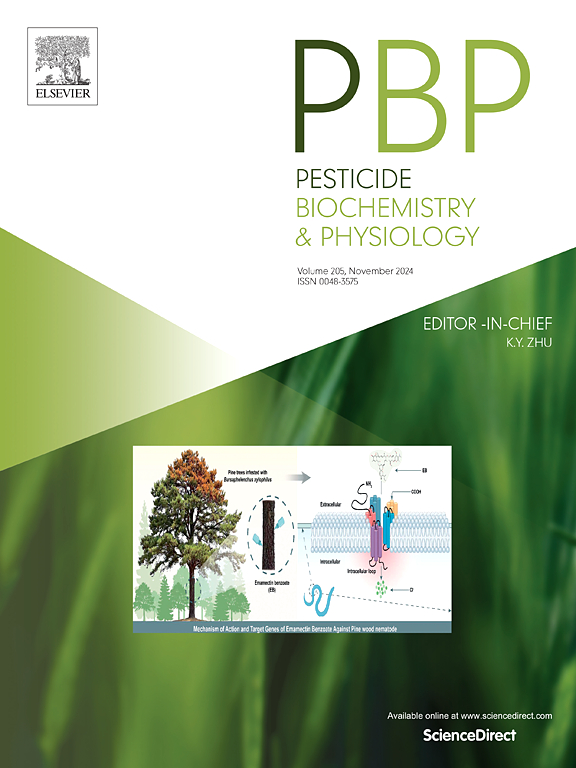用dsRNA沉默脂肪酰基辅酶a还原酶会破坏飞蝗脂质基角质层屏障
IF 4.2
1区 农林科学
Q2 BIOCHEMISTRY & MOLECULAR BIOLOGY
引用次数: 0
摘要
表皮碳氢化合物(CHCs)防止大量水分流失,因此对昆虫在炎热和干燥环境中的生存至关重要。迁徙蝗是一种广泛存在的农业害虫,在其自然栖息地暴露在高温下。为了了解迁徙乳杆菌抗干燥的分子机制,我们鉴定并鉴定了一个脂肪酰基辅酶a还原酶基因(LmFAR)。LmFAR在被膜和脂肪体中高表达。此外,我们发现LmFAR蛋白定位于卵泡细胞。在抑制LmFAR后,90%以上的蝗虫死亡,身体含水量降低。dsLmFAR处理后的昆虫表皮结构松散,角质层屏障被破坏,表明FAR产物与甲壳素基质结合很重要。经dsLmFAR处理的蝗虫对干燥条件的敏感性增加,促进了外源生物和杀虫剂的渗透。GC-MS分析的CHC定量和Bodipy原位脂质检测均表明,敲低LmFAR导致角质层总脂质含量降低。综上所述,LmFAR有助于蝗虫体内正常的CHC量和角质层完整性,从而有助于蝗虫对水分变化的适应。本文章由计算机程序翻译,如有差异,请以英文原文为准。
Silencing fatty acyl-CoA reductase with dsRNA damaged the lipid-based cuticle barrier in Locusta migratoria
Cuticular hydrocarbons (CHCs) prevent massive water loss and are therefore essential for insect survival in scorching and dry environments. Locusta migratoria, a widespread agricultural pest, is exposed to elevated temperatures in its natural habitat. To understand the molecular mechanisms in L. migratoria against desiccation, we identified and characterized a fatty acyl-CoA reductase gene (LmFAR). LmFAR was highly expressed in the integument and fat body. Moreover, we found that LmFAR protein was localized in oenocytes. After suppressing LmFAR, over 90 % locusts died with a reduction of body water content. The procuticle structure of dsLmFAR treated insects was loose and cuticle barrier was disrupted, suggesting that FAR products are important to incorporate into the chitin matrix. dsLmFAR treated locusts showed increased sensitivity to desiccation conditions, xenobiotics and insecticides penetration was facilitated. CHC quantification by GC–MS analysis and in situ lipid detection by Bodipy both indicated that knockdown of LmFAR resulted in a decrease in total cuticle lipid amounts. In conclusion, LmFAR contributes to normal CHC amounts and cuticle integrity in locusts, thereby contributing to their adaptation to water variation.
求助全文
通过发布文献求助,成功后即可免费获取论文全文。
去求助
来源期刊
CiteScore
7.00
自引率
8.50%
发文量
238
审稿时长
4.2 months
期刊介绍:
Pesticide Biochemistry and Physiology publishes original scientific articles pertaining to the mode of action of plant protection agents such as insecticides, fungicides, herbicides, and similar compounds, including nonlethal pest control agents, biosynthesis of pheromones, hormones, and plant resistance agents. Manuscripts may include a biochemical, physiological, or molecular study for an understanding of comparative toxicology or selective toxicity of both target and nontarget organisms. Particular interest will be given to studies on the molecular biology of pest control, toxicology, and pesticide resistance.
Research Areas Emphasized Include the Biochemistry and Physiology of:
• Comparative toxicity
• Mode of action
• Pathophysiology
• Plant growth regulators
• Resistance
• Other effects of pesticides on both parasites and hosts.

 求助内容:
求助内容: 应助结果提醒方式:
应助结果提醒方式:


